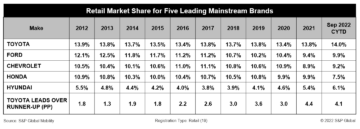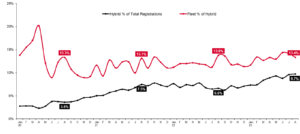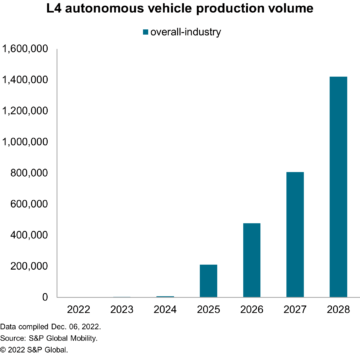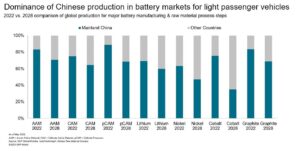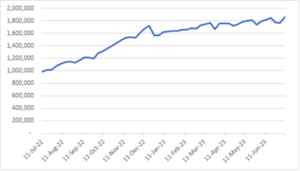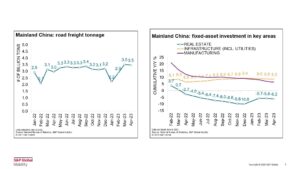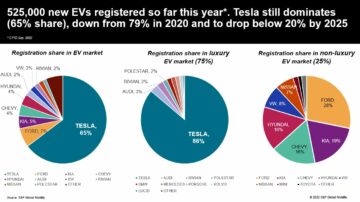LISTEN TO THIS PODCAST
Vehicle inventories are returning to dealer lots,
purchasing methods are changing, and car-shoppers are expecting
more of the transaction process to occur online.
The easy days of selling from low inventories are over. Brands,
dealers, and salespeople need to start fighting for auto buyer
attention and consideration once again, and need to work together
to win. As inventories continue to move toward pre-pandemic levels,
customers are finding themselves with more freedom when it comes to
selecting a vehicle, the price they pay, and how they shop.
Nowhere was this looming trend more evident than on the NADA
show floor in Dallas, where thousands of dealers, vendors, and
automaker reps came together to discuss the near- and long-term
future of automotive retail.
Inventories Are Coming Back
While still nowhere near pre-COVID levels, S&P Global
Mobility analysis shows that dealer advertised inventory has
been steadily increasing over the past six months across both
mainstream and luxury markets. On average, mainstream customers
have over 50% more inventory to shop from than they did six months
ago; and luxury customers, about 40% more.
This uptick in advertised inventory is adding some autonomy back
into customers’ purchase decisions. “There’s not as much pressure
to take what’s on the lot today, so customers are able to shop
different brands and dealerships more than over the past year or
so,” said Kristen Balasia, vice president of advisory services at
S&P Global Mobility.
We’re also seeing that US car-shoppers who don’t need a vehicle
urgently are more willing to order and wait for the car they want.
Retailers need to be prepared for potential customers to start
shopping around again ahead of signing purchase agreements.
Customers are searching for more than just the vehicle, they’re
also out looking for the deal they want, according to our Vehicle Buyer Journey survey.
As inventories continue to creep up, so will the incentives and
discounts. For most of the past two years, the high-demand vs
short-supply gap almost guaranteed a new-car shopper would pay well
more than sticker price – which also drove used-car prices
higher.
As the gap narrows (albeit still sizeable from traditional
norms), we’re starting to see more vehicles listed for less than
MSRP. As of January, S&P Global Mobility analysis shows that
40% of inventory is being advertised with some kind of discount,
compared to less than 20% six months ago. (Dealer inventories that
did not list pricing are excluded from this calculation.)
Customers can now be pickier with the vehicle and price, which
translates into being picky about the brand and dealership they
want to buy from. This likely means a return of cash and APR
incentives to close the deal.
“Brands and dealers should be mindful of what offers potential
buyers are seeing online or see hitting their mailboxes. With more
availability and competition, the fight for market share and
loyalty is back,” Balasia said.
S&P Global Mobility research shows a decline in brand
loyalty while inventory was scarce. Now loyalty is rebounding
slightly as inventories rise. But will that continue, or will
customers continue to shop around? Retailers need to have the right
procedures in place to keep their remaining customers and lure back
the defectors.
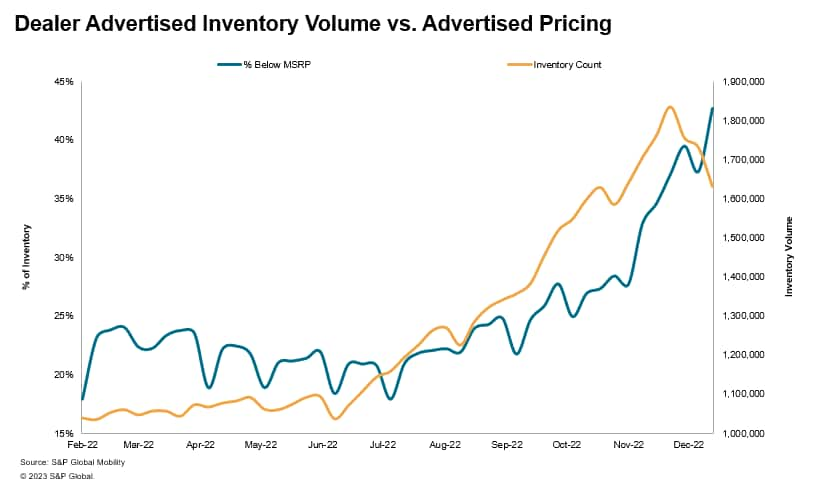
On average, as advertised inventory increases, the percentage of
advertised listings priced below MSRP also increase, reaching more
than 40% in January.
Digital Retail Transformation
One of the more potent retail concepts is, “Right product, right
price, right place.” We know that customers are more willing to
wait for the right product, and shop for the right price. An
increasing trend in data also confirms a transformation to digital
retail. More than ever, the “place” is no longer only a physical
location. This was borne witness at NADA, where so many
conversations involved the evolution in digital tools and
processes.
Car shoppers have long been initiating the buying process online
by manually comparing and researching. But online comparison tools
are merely table stakes; being able to complete parts of the
lengthy (formerly entirely in-dealership) transaction process
online is the new differentiator. The availability of these
conveniences is not a nice-to-have amenity; consumers tell us that
they’ve driven further, and interacted with unfamiliar dealerships,
to get the desired online experience.
Many vehicle buyers surveyed in 2022 stated they expect to
complete their next vehicle purchase entirely online. Retailers
should be ready to allow their customers virtual access to the
process of buying a vehicle.
“Whether this means dealerships open their virtual doors to
parts of the process like F&I, or offer the option for a
completely online transaction, it’s the direction that consumers
are pushing us in, and they’ll go where they need to to find it.”
said Balasia. And while the vast majority of car shoppers still
expect to conduct test drives, they want to schedule them online
and have the experience delivered right to their driveway.
The growth in EVs
The arrival of electric vehicles into the internal-combustion
marketplace is having unintentional consequences for dealers and
manufacturers.
Selling an EV is a completely different sport than selling an
ICE vehicle. Even brand-loyal customers
are basically starting over when purchasing an EV; consumers
moving to electric vehicles in 2022 are largely doing so from
Toyota and Honda.
“With all the new EV entrants hitting the market, a customer
deciding that an EV fits their lifestyle is entering a different
class and competitive group for potential options than they’ve
previously considered,” said Joe Kyriakoza, vice president, Polk
Automotive Solutions at S&P Global Mobility. “Brands will need
to think differently about their marketing strategies in order to
stand out against this different pool of competitors.”
We’re still in the early days of the EV conversation for
dealers, but savvy dealers know that this revolution is coming and
that it will impact the way they do business. They’re looking at
the time and monetary investments needed to compete in the EV world
and learning the different processes required to sell an EV.
Salespeople in dealerships also need to embrace a different
knowledge set on what EV ownership looks like to properly educate
and ultimately sell to customers. EVs are requiring a new step in
the sales process; salespeople need to guide customers on how to
own an EV, rather than just how to purchase it.
It’s not just a different driving experience. EV customers need
to feel comfortable knowing how they’re going to live with their
vehicle. Which charging stations can they use? How will different
station types impact charging times and range? Is the EV buyer’s
house properly equipped to have a charger installed?
Another disruptive aspect of EVs is in marketing. “You would
market an electrified version much differently than the ICE version
of the same vehicle,” Kyriakoza said. “Your competitive set would
be different, your audience would be different, and so would the
channels by which you reach your customers. We’re constructing and
launching entirely new
audiences to support EV marketing.”
All aspects of this new environment tell us that selling is
coming back into the picture. Being sold a car is organically
growing to be part of the consumer process again. Customers are
walking away from what would have been a done deal six months ago;
every step of the sales process needs to be tailored to meet the
new expectations of our product’s audience.
With increasing expectations and competition, dealers and brands
need to take a deep look into how their products, incentives,
processes, and marketing align with their customer. Everyone
involved on the retail side needs to commit to these changes or
else risk being left behind.
Author: Grant Gitre, Consulting Associate Director, S&P
Global Mobility
————————————————————–
Dive deeper into these marketing assets:
Register Now: Join our 2023
Automotive Loyalty Summit Webinar on Feb. 28th
Read the Blog: Americans appear
ready for the European car-ordering model
Register Now: 2023 Brand
Performance Review Webinars – March 16 & 23
Download: Polk Audiences: Learn
more about our new EV segments
This article was published by S&P Global Mobility and not by S&P Global Ratings, which is a separately managed division of S&P Global.
- SEO Powered Content & PR Distribution. Get Amplified Today.
- Platoblockchain. Web3 Metaverse Intelligence. Knowledge Amplified. Access Here.
- Source: http://www.spglobal.com/mobility/en/research-analysis/fuel-for-thought-the-old-way-of-selling-cars-wont-work-anymore.html
- 2022
- 2023
- a
- Able
- About
- access
- According
- across
- advisory
- advisory services
- against
- agreements
- ahead
- All
- Americans
- analysis
- and
- appear
- around
- arrival
- article
- aspect
- aspects
- Assets
- Associate
- attention
- audience
- audiences
- auto
- automotive
- availability
- average
- back
- Basically
- behind
- being
- below
- Blog
- brand
- brands
- business
- buy
- buyers
- Buying
- car
- cars
- Cash
- Changes
- changing
- channels
- charging
- charging stations
- class
- Close
- comfortable
- coming
- commit
- compared
- comparing
- comparison
- compete
- competition
- competitive
- competitors
- complete
- completely
- concepts
- Conduct
- Consequences
- consideration
- considered
- constructing
- consulting
- consumer
- Consumers
- continue
- Conversation
- conversations
- customer
- Customers
- Dallas
- data
- Days
- deal
- dealer
- Deciding
- decisions
- Decline
- deep
- deeper
- delivered
- DID
- different
- differentiator
- digital
- direction
- Director
- Discount
- discounts
- discuss
- disruptive
- Division
- doing
- doors
- driven
- driving
- Early
- educate
- Electric
- electric vehicles
- embrace
- entirely
- entrants
- Environment
- equipped
- Ether (ETH)
- European
- EV
- Even
- EVER
- Every
- everyone
- evolution
- excluded
- expect
- expectations
- expecting
- experience
- fight
- fighting
- Find
- finding
- Floor
- formerly
- Freedom
- from
- Fuel
- further
- future
- gap
- get
- Global
- Go
- going
- grant
- Group
- Growing
- Growth
- guaranteed
- guide
- having
- higher
- hitting
- House
- How
- How To
- HTML
- HTTPS
- ICE
- Impact
- in
- Incentives
- Increase
- Increases
- increasing
- inventory
- Investments
- involved
- IT
- January
- join
- journey
- Keep
- Kind
- Know
- Knowing
- knowledge
- largely
- launching
- LEARN
- learning
- less than 20%
- levels
- lifestyle
- likely
- List
- Listed
- Listings
- live
- location
- Long
- long-term
- longer
- Look
- looking
- LOOKS
- looming
- Lot
- Low
- Loyalty
- Luxury
- Mainstream
- Majority
- managed
- manually
- Manufacturers
- many
- March
- Market
- Marketing
- marketplace
- Markets
- means
- Meet
- merely
- methods
- mobility
- Monetary
- months
- more
- most
- move
- moving
- Near
- Need
- needed
- needs
- New
- next
- offer
- Offers
- Old
- online
- open
- Option
- Options
- order
- organically
- own
- ownership
- part
- parts
- past
- Pay
- percentage
- performance
- physical
- picture
- Place
- plato
- Plato Data Intelligence
- PlatoData
- pool
- potential
- prepared
- president
- pressure
- previously
- price
- Prices
- pricing
- procedures
- process
- processes
- Product
- Products
- properly
- published
- purchase
- purchasing
- Pushing
- range
- ratings
- RE
- reach
- reaching
- ready
- remaining
- required
- research
- retail
- retailers
- return
- returning
- review
- Revolution
- Rise
- Risk
- S&P
- S&P Global
- Said
- sales
- Salespeople
- same
- savvy
- schedule
- searching
- seeing
- selecting
- sell
- Selling
- Services
- set
- Share
- Shop
- Shoppers
- Shopping
- should
- show
- Shows
- signing
- SIX
- Six months
- So
- sold
- Solutions
- some
- Sport
- stand
- start
- Starting
- stated
- station
- Stations
- Step
- Still
- strategies
- Summit
- support
- surveyed
- table
- tailored
- Take
- test
- The
- their
- themselves
- thought
- thousands
- time
- times
- to
- today
- together
- tools
- toward
- toyota
- traditional
- transaction
- Transformation
- Trend
- types
- Ultimately
- unfamiliar
- us
- use
- Vast
- Ve
- vehicle
- Vehicles
- vendors
- version
- Vice President
- Virtual
- wait
- walking
- webinar
- Webinars
- What
- whether
- which
- while
- WHO
- will
- willing
- win
- witness
- Work
- work together
- world
- would
- year
- years
- Your
- zephyrnet



